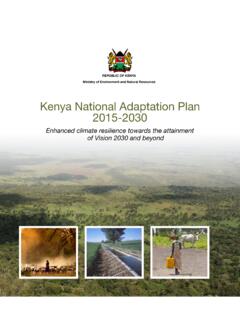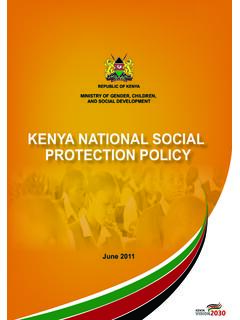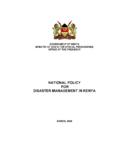Transcription of MATERNAL AND CHILD HEALTH KENYA - WHO
1 MATERNAL AND CHILD HEALTH : KENYA . KENYA EXPERIENCES SLOW PROGRESS IN Others are due to causes such as malaria, diabetes, hepatitis, and anaemia, which are aggravated by MATERNAL HEALTH . pregnancy (Figure 1). MATERNAL morbidity and mortality relate to illness or death occurring during pregnancy or childbirth, or Figure 1: Leading causes of MATERNAL mortality: within two months of the birth or termination of a Regional estimates for sub-Saharan Africa (1997-2007).2. pregnancy. The fifth Millennium Development Goal Embolism (MDG) aims to reduce the MATERNAL mortality ratio by Sepsis 1%.
2 9%. 75% between 1990 and 2015. In KENYA , MATERNAL Abortion mortality remains high at 488 MATERNAL deaths per 9% Haemorrhage 100,000 live While this is below the Sub-Saharan 34%. average of 640 deaths per 100,000, KENYA experiences Other direct a very slow progression in MATERNAL HEALTH . 11%. Most MATERNAL deaths are due to causes directly related to pregnancy and childbirth unsafe abortion and obstetric complications such as severe bleeding, Indirect infection, hypertensive disorders, and obstructed labor. 17% Hypertension 19%. MATERNAL and CHILD HEALTH : KENYA Page 1.
3 While approximately 92% of women giving birth to severe infections, followed by birth asphyxia, received some antenatal in 2010, only 47% had the preterm births and congenital anomalies (Figure 2). recommended four or more. 56% of Kenyan women Two-thirds of under-5 deaths are post-neonatal2 and deliver at home, with home births being more leading causes of these deaths are pneumonia and diarrhea. common in rural areas and only 44% of births were In 2009, KENYA also experienced over 34,000 assisted by a HEALTH care professional (doctors, nurses and midwives)1. These rates of antenatal care and Figure 2: Under-5 cause of death in KENYA (2010).
4 8. skilled birth attendance have declined over the past 10 Pneumonia (post-neonatal). Diarrhoeal diseases 14%. years, particularly among the (post neonatal). 19%. MATERNAL morbidity and mortality in KENYA results from Other 15%. the interplay of social, cultural, economic and logistical HIV/AIDS. barriers, coupled with a high fertility rate and 9%. inadequate and under-funded HEALTH services. Injuries Strengthening the HEALTH system and improving quality 3%. Malaria of healthcare delivery is pivotal to reversing the trend 3%. Measles of high MATERNAL morbidity and 1%.
5 NCD. 2%. Together with income, education also plays a major Neonatal causes 34%. role in determining MATERNAL HEALTH outcomes, including fertility rates, access to family planning, and antenatal In KENYA one-third of children under-5 is stunted coverage. Women with higher education are much (too short for their age), a sign of chronic malnutrition. more likely to receive antenatal care from a medical Also, 1 in 6 children is underweight or too thin for doctor than are those with no education (36 vs. 21%). their Years of drought have had a serious impact Similarly, the higher the wealth quintile, the more likely on KENYA 's children, increasing malnutrition rates, a woman is to get antenatal care from a morbidity and , 2.
6 Restrictive abortion legislation also contributes Figure 3: Disaggregated under-5 substantially to MATERNAL mortality and morbidity in 120. TH. KENYA RANKED 39 GLOBALLY IN. 100. 112. UNDER-5 DEATHS 98. 80 86. Over 7 million children under-5 years of age die each 74. 68. 60. year mainly from preventable and treatable conditions. 59. Pneumonia, diarrhoea and malaria remain the leading 40. cause of CHILD mortality, and under nutrition contributes 20. to more than 1/3 of all deaths. Millions of children 0. could be saved each year if proven interventions such Urban Rural Mother Mother with Lowest Highest w ith no secondary w ealth wealth as antibiotics for pneumonia, oral rehydration therapy education education quintile quintile for diarrhoea, and the provision of insecticide treated Mortality is higher in rural areas, however residents nets (ITNs) to prevent malaria, were universally available.
7 Of urban slum settlements exhibit worse HEALTH While infant and under-5 mortality rates have declined indicators, especially for the under-5 since 1990, mainly due to programs in childhood Socioeconomic status is a key determinant of survival, immunization and malaria prevention, KENYA is still with children in the lowest wealth quintile 44% more ranked the 39th country with the highest deaths , 6 likely to die before age 5 than those in the highest KENYA is not on track to meet MDG 4 to reduce the The coverage of key CHILD survival interventions under-5 mortality by two thirds between 1990 and along the continuum of care shows the richest families 2015.
8 Nearly 35% of under-5 deaths occurred during are 3 times more likely to receive care than the the neonatal period; 1/3 of all neonatal deaths are due poorest families. MATERNAL and CHILD HEALTH : KENYA Page 2. The biggest differential in the under-5 mortality ratio in Key priorities being pursued to rectify this include a KENYA is related to mother's education (Figure 3). push to increase Government HEALTH Expenditures, a Children whose mothers are not educated are 46% reduction in out of pocket spending through the 20/10. more likely to die before age 5 than those whose policy, strategies to eliminate fees at point of use, and mothers have higher than secondary level of , 10 exploration of pre-payment mechanisms as a future focus of equitable HEALTH financing.
9 The Bill of Rights specifically highlights the rights of WATER SUPPLY, SANITATION AND. Children to basic nutrition and healthcare, as well as HYGIENE (WASH) IN KENYA more generally states that all Kenyans have a right to Over 13 million Kenyans the highest attainable standard of HEALTH , including lack access to an the right to life, reproductive HEALTH , and other improved water supply attributes of good HEALTH . and 19 million lack access In 2010, the Global strategy for Women's and to improved sanitation, Children's HEALTH was launched by the office of the and water supply, United Nations Secretary-General.
10 The Initiative calls sanitation and hygiene for a bold, coordinated effort around MDGs 4 and 5, (WASH)-related diseases building on what has been achieved so far - locally, and associated conditions nationally, regionally and globally. It calls for all partners ( anemia, dehydration to unite and take action through enhanced financing, and malnutrition) are the strengthened policy and improved service delivery. number one cause of KENYA has made the following commitments to the under-5 hospitalization Global strategy : and mortality. Over 50% of hospital visits in KENYA for Recruit and deploy an additional 20,000 primary care illnesses are related to Although KENYA has HEALTH workers.


















